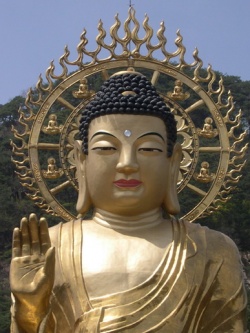Vipassana (Path Knowledges)
- When we first begin vipassana meditation we do not know the real object of the practice; we may be familiar with the words, but we have not yet experienced or fully understood this object.
This object is knowing the three characteristics, dukkha, anicca, anatta (tilakkhana) of the rising and falling of the five aggregates, rupanama (body and mind).
We may well be familiar with unsatisfactoriness, impermanence, and non-self, but we have yet to relate this, and thus allow this understanding to fully soak into our being, with rupanama rising and falling away.
Bhanga-nana (knowledge of dissolution)
When the five indriya (saddha, confidence, viriya, energy, sati, mindfulness, samadhi, concentration, and pannya, wisdom) become more balanced we are then able to note the present objects more skillfully and the process of noting will begin to speed up.
The noting of rising and falling of the abdomen and all other objects will speed up and they will vanish quickly, to the extent that eventually we will only notice vanishing.
Sometimes the objects noted are not clear, simply noted and vanishing, and both the object and the one who notes will disappear into emptiness.
At this stage the meditator has realized the knowledge of dissolution.
Bhaya-nana knowledge of fear
At this stage, the objects noted and the noting mind always vanish together, and when samadhi is strong even the body may vanish. This gives rise to fear.
At this stage, whatever object the meditator notes will be seen as dukkha, and they will come to realize the true nature of all sankhara (conditioned phenomena).
Dukkha is not merely a philosophical description; at this stage the meditator will meet the true taste of dukkha.
Nibbida-nana (knowledge of contemplating rupanama with boredom or disgust
This stage speaks for itself.
Muncitu-kamyata-nana knowledge of the desire for deliverance
At this stage, the meditator will often feel as if they have had enough, and they want to stop practicing and leave.
They feel restless, and sometimes have trouble sitting due to sensations of itchiness over their body.
They no longer find anything enjoyable and want the mind to become still and calm.
Patisankha-nana knowledge of re-observation
When noting the rising, falling and other objects, meditators find that they arise and vanish quickly; nothing enduring or substantial, and dukkha, annica, and anatta become even more apparent.
Sankarupekkha-nana knowledge of equanimity towards sankhara
At this stage, the meditator will find that practice can be maintained for long periods without feeling bodily pain, and that noting is easy and comfortable.
The mind is undisturbed by thoughts and follows the rising and falling with ease.
The mind can be observed without effort, and the arising and falling of objects and the noting mind become extremely subtle.
Depending upon the meditator, and their strength of practice, this stage may not become apparent initially, and they may fall back to the 9th or 10th nana several times before their sati and samadhi are strong enough to fully realize this knowledge.
The main problems are attachment to thoughts and moods, and if noting and letting go are not well established then they will be unable to realize this knowledge.
This vipassana knowledge is the first part of what is known as vutthanagamini vipassana (insight leading to emergence) and is the prerequisite for the arising of the path process involving the five remaining knowledges.
Path Process
Anuloma-nana knowledge of adaptation
This is the final part of vutthanagamini vipassana and represents the fully developed upacara samadhi (access concentration) using the rise and fall of the five aggregates as its object.
In the first three knowledges, the meditator realizes the parikamma (preparatory sign) of vipassana; experience of the arising, change, and vanishing of the rise and fall of rupanama.
From the fourth knowledge onwards, the true vipassana knowledges, the meditator develops a clear understanding of the dukkha, annica, and anatta nature of the five aggregates.
Anuloma-nana adapts to the previous eight pure vipassana knowledges.
In every act of noticing, there arises parikamma, upacara, anuloma, patiloma (preparation, access, proceeding, receding) because the strength of anuloma is insufficient.
As vipassana knowledge develops, understanding of dukkha, annica, and anatta strengthens and this process changes to parikamma, upacara, anuloma, gotrabhu (preparation, access, proceeding, maturity).
The first three conscious moments of the path process are called Anuloma-nana.
(The above process is that as described for pannya vimutti (deliverance by wisdom), which is not quite the same as when practicing ceto vimutti (deliverance by heart), i.e. developing mundane jhanas, exiting jhana, and contemplating the four foundations of mindfulness.
Those who begin by jhanas have cittavisuddhi (purity of heart) from the outset, albeit temporarily, and due to their control of the mind (impurities in the mind are willfully suppressed through appana samadhi, fixed concentration) will not experience the defilements of insight.
The path process for ceto vimutti is therefore upacara, anuloma, gotrabhu.)1
Gotrabhu-nana maturity knowledge
This is the knowledge that changes the lineage of the meditator, from mundane mind to supramundane mind (Aryan); opening the door to nirvana. It arises in quick succession to Anuloma-nana.
Magga-nana path knowledge
Arising in quick succession to Gotrabhu-nana, Magga-nana is an experience of unconditioned (sunyatta) and indestructible (amata) reality, nirvana.
Phala-nana fruition knowledge
Arising in quick succession to Magga-nana, and while Magga-nana can never be experienced again, Phala-nana may return when practice is continued (thus references to using path knowledge, nana, or yahn, mean path fruition knowledge).
Paccavekkhana-nana knowledge of reviewing
This knowledge reviews the Magga-nana that has just occurred; it is worldly mind, in that its object is the rupanama or remaining impurities in the mind.
The five knowledges that constitute the path process occur very quickly, just like a single act of noticing.
Following this, the practice continues using the path fruition knowledge as the object of samadhi (with the long out breath).
Mindfulness
The whole process of vipassana development begins with mindfulness of breathing, either with the above direct vipassana method or through the development of mundane jhanas and contemplating the four foundations of mindfulness.
Mindfulness is not just a word, it is a method, thus without noting the meditator has little mindfulness.
It is also worth pointing out that the path begins quite easily, and perhaps as a reflection of the path of mind purification as a whole, there are times in the middle stages when it is a struggle and there appears to be no light at the end of the tunnel.
Thus, those who think that vipassana meditation is only for calm or happy feelings will soon fall by the wayside.
To break free of samsara requires dedication and effort; you have to persevere and become ruthless in non-attachment.
Being able to note whatever arises and then exercise direction by moving the mind back to the breath fills this role.
1 Meditators should not become too impressed by the term 'Purity of Heart' (mind) as this is merely a description that applies only to the mind in fourth jhana when all impurities are suppressed and the mind becomes radiant (verifiable by Dibbacakkhu, one of the five abhinnya, or higher mundane knowledges).
Anything lower than fourth jhana, then the mind is not so pure.
It should also be noted that it is 'Purity of Heart, yet lacking in wisdom' and developing this wisdom from contemplating the four foundations of mindfulness is another thing altogether.
Before The Buddha came along, yogis had been practicing jhanas for a long time with little benefit other than the actual technique (skill in developing anuloma, gathering samadhi).
However, it was this technique, rather than the level of jhana, that made it possible for them to develop vipassana easily under his guidance.
................
These knowledges developed through vipassana meditation are the true savior, and they are permanent, they soak into your being, so even if someone does not reach the end in one lifetime they remain part of the mind that moves on.








